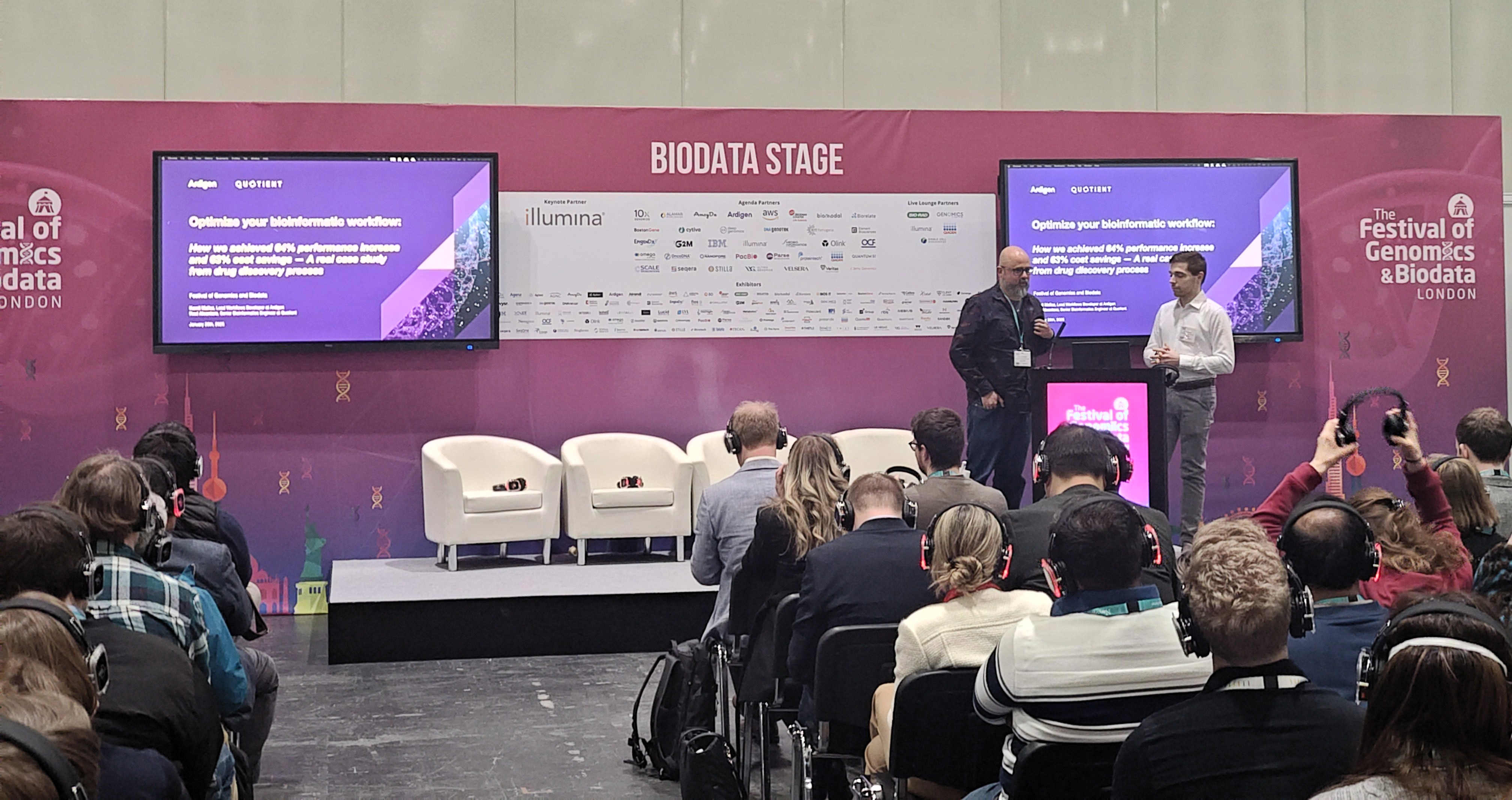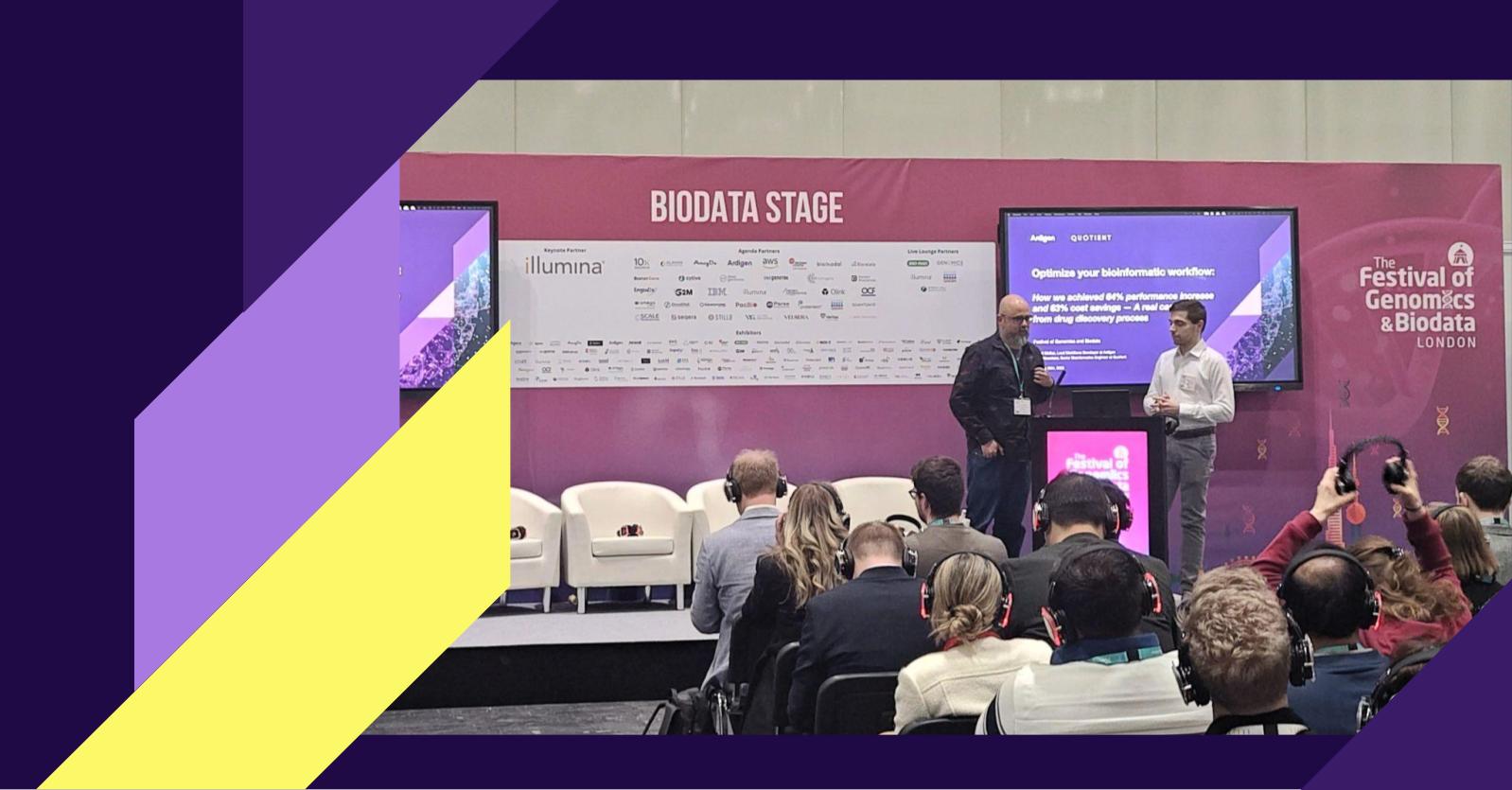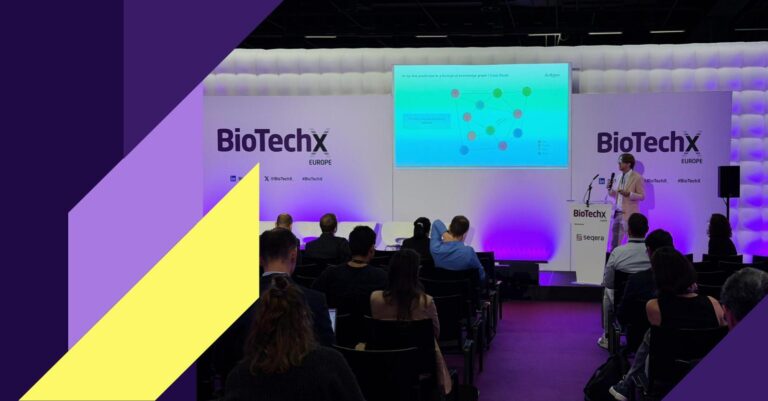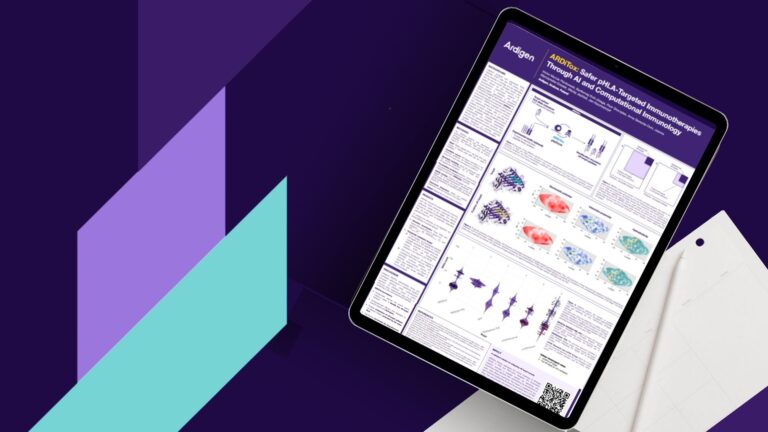In February, Ardigen had the pleasure of attending the Festival of Genomics & Biodata—the UK’s largest genomics gathering, featuring topics like multiomics, single cell and spatial analysis, workflows, biodata and much more.
Although some time has passed since the event, the insights and discussions remain highly relevant, shaping the future of genomics and biodata. Below, we’ve gathered some of our key observations and insights.
One presentation that was particularly important for us was the talk by Ardigen’s Lead Nextflow Developer, Kamil Malisz. Together with Raul Alcantara, Senior Bioinformatics Engineer at Quotient Therapeutics, he presented a case study demonstrating how bioinformatics workflow optimization can lead to substantial performance improvements, cost reductions, and enhanced scalability and maintainability for companies like Quotient Therapeutics.
You can learn more about this project by checking the case study and watching the video from the presentation.
New horizons in genomics technologies
Several announcements with the potential to impact on the future of healthcare and drug discovery and development research were made during the event. One of the most notable was the UK National Health Service’s (NHS) strategy to develop a Unified Genomic Record, allowing healthcare professionals a more seamless access to genomic data.
On the technology development side, Illumina introduced a new sequencing and analysis platform called Constellation Mapped Read Technology. This innovative sequencing method enhances short-read sequencing (SBS) with long-range genomic insights. By leveraging on-flow-cell library preparation and spatial proximity analysis, this technology significantly improves mapping, phasing, and structural variant detection while maintaining the scalability and accuracy of SBS.
Illumina also unveiled a groundbreaking spatial transcriptomics technology, enabling high-resolution, whole-transcriptome analysis of tissues at an unprecedented scale. The technology, integrated with Illumina’s sequencing platforms, allows researchers to map complex tissues with greater sensitivity and resolution, supporting insights into diseases like cancer, pulmonary fibrosis, and neurobiology.

These two technologies are part of Illumina’s broader strategy to expand sequencing beyond simple DNA/RNA reads and integrate multiomic insights. Their combined use could drive more comprehensive, high-resolution biological discoveries across fields like oncology, neurology, and complex disease research. This approach holds the potential for improving equity in genetic disease screening by enabling whole-genome sequencing of newborns from cord blood.
Several presentations also highlighted the importance of long-read sequencing technologies and approaches such as T2T (telomere-to-telomere) assemblies for capturing structural variants. Oxford Nanopore introduced the concept of adaptive sampling, a method that enables targeted sequencing of repeat regions by selectively sequencing specific molecules. When it came to genomics workflows, Nextflow continues to be the management system of choice for many organizations. Seqera released a new feature in Fusion, which allows to resume compute while spot instance is reclaimed, enhancing efficiency and usability.
Beyond genomics: proteomics insights
Despite its name, the Festival of Genomics featured important discussions across other “omics” fields as well. Of particular interest, Dr. Chris Whelan, Director of Neuroscience Data Science at Johnson & Johnson who leads a systems biology and multi-omics team, delivered a presentation titled “What’s Next for Next-Generation Proteomics?”
Whelan highlighted the evolution of omics research since the completion of the Human Genome Project 25 years ago. In this time, research focus has shifted from the Human Genome Project to genome-wide association studies (GWAS) and population genomics to now population proteomics. The potential of proteomics is substantial, as it can partially address the limitations of GWAS studies in understanding disease mechanisms, and advance precision medicine.
As Whelan noted, there is an increasing recognition that “proteins speak louder than genes” when it comes to addressing many of the current drug discovery challenges. Over the last three years, the applications of next-generation proteomics as a drug discovery and precision medicine tool have expanded exponentially. These advances have been driven by increased multiplexing, improved throughput, lower costs and targeted private-public investments, such as the UK Biobank Pharma Proteomics Project.
The Pharma Proteomics Project conducted a pilot study measuring over 3,000 proteins in nearly 50,000 participants using Olink technology. This effort identified 14,000 protein quantitative trait loci (pQTLs) using UK Biobank data and revealed 577 proteins linked to Parkinson’s disease. In the next stage, researchers have set an even more ambitious goal of measuring up to 5,400 proteins in each of 600,000 samples through the Pharma Proteomics Project.
Whelan also underscored the potential of generative AI to enhance this growing field. The analysis of the datasets from pilot Pharma Proteomics Project study, which Ardigen was involved in carrying out, showed that neural networks are able to differentiate different disease states based on proteomic signatures. As the number of samples increases from 50,000 to 600,000, this will enable starting to build foundational models for biology.
The applications of next-generation proteomics are poised to expand even further, including larger population-scale proteo-genomics studies and increased implementation in drug development and clinical settings. Future research will emphasize integrating proteomics in clinical trials and its potential for early disease detection, supported by advancements in mid-plex assays that can be used in clinical settings.
Towards AI-powered rational drug design
Finally, an undeniable highlight of the conference was a visionary presentation by Sergei Yakneen, Chief Technology Officer at Isomorphic Labs. The company aims to redefine drug discovery from first principles by leveraging tools such as AlphaFold 3 for de novo molecule design and binding affinity prediction, along with using other AI-powered technologies for solving the current gaps in the drug discovery process.
Yakneen discussed the current inefficiencies in drug discovery, including the 13.5-year average time from research to market approval, the $3 billion cost per new drug, and the high failure rate of drugs in clinical trials due to lack of efficacy and toxicity. Isomorphic Labs has focused its efforts on identifying and addressing the key bottlenecks in the drug discovery process, including limited understanding of disease biology, compound design, compound quality, and scalability.
By developing foundation models to uncover novel targets and accurately modeling the dynamics of biological systems to make the undruggable universe more tractable, Isomorphic aims to reduce the number of design cycles to a single iteration in the future. Achieving this will require building strong collaborative partnerships between industry, academia, and clinics to generate and share diverse data sets, as well as improving data accessibility through public resources like the Protein Data Bank and other initiatives that can provide diverse data types needed for machine learning.
Paving the road ahead
Festival of Genomics & Biodata serves as a place for the global genomics community to exchange knowledge, showcase advancements and empower future research. We were inspired by the rapid progress in omics data technologies, which are shaping the future of drug discovery and healthcare. Ardigen is proud to be a part of this community, and we look forward to sharing our insights at future conferences!




